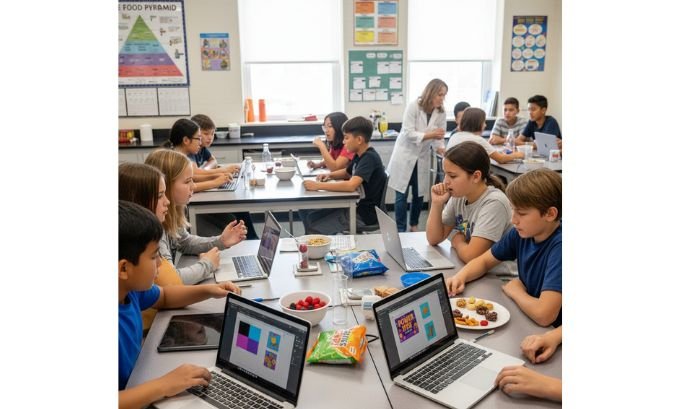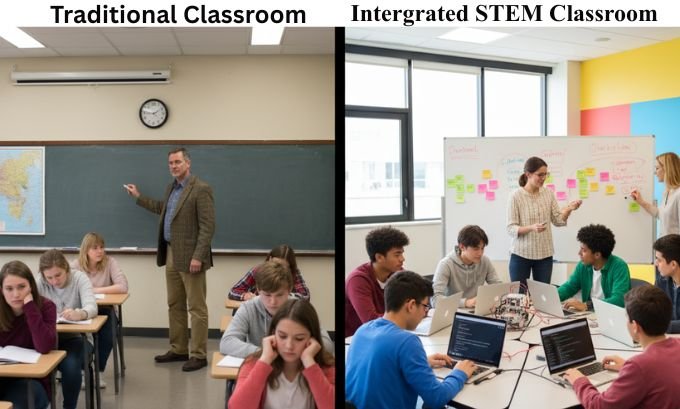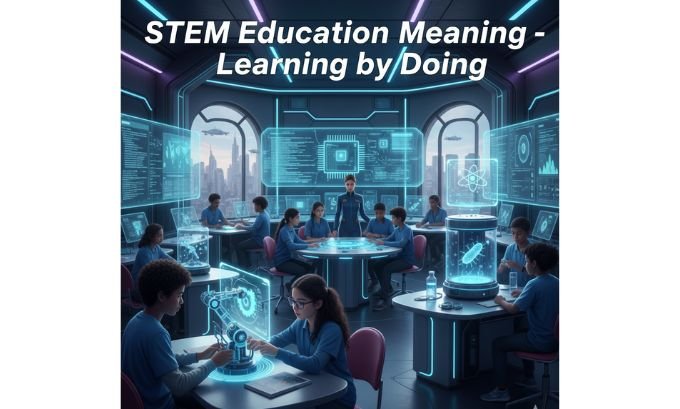The real STEM education meaning is about connection and creation. It’s an educational philosophy that brings Science, Technology, Engineering, and Mathematics together, not as separate subjects, but as a dynamic, interconnected toolkit for solving real-world problems. This approach shifts the focus from memorization to hands-on application, building the creative and critical thinking skills our future demands.
Table of Contents
Cracking the Code: The True Meaning of STEM Education
At its heart, the STEM education meaning is about learning by doing. It’s a method that dissolves the traditional classroom walls between Science, Technology, Engineering, and Mathematics. An Integrated STEM Education program challenges students to see how these disciplines work in concert. Instead of just learning the formula for velocity, they design and build a vehicle to test it. Rather than just studying ecosystems, they design a self-sustaining terrarium.
This educational model is a thoughtful response to a world that is becoming more complex. For years, forward-thinking organizations like the National Science Foundation (NSF) and the American Association for the Advancement of Science (AAAS) have championed this integrated approach. They recognized early on that to inspire a generation of innovators, learning needs to be an active, engaging process, starting from the earliest days of K-12 Education.
The Birth of an Acronym
While the push to improve science and math literacy has been around for decades, the STEM acronym we use today is a more recent development. Around 2001, Judith A. Ramaley, a biologist and then-director at the National Science Foundation (NSF), helped cement the term in the public lexicon. It provided a simple, powerful label for a complex educational movement.
Before “STEM,” countless initiatives aimed at similar goals often worked in isolation. The formal adoption of STEM (Science, Technology, Engineering, and Mathematics) by the NSF created a shared vocabulary. This unified identity helped focus national resources and policy on a common goal: preparing students for the 21st century and strengthening America’s global competitiveness.
A National Call to Action
The STEM movement gained significant momentum after several high-profile reports highlighted a growing skills gap. One of the most influential was the 2007 report Rising Above the Gathering Storm, released by a committee under the National Research Council (NRC). Its message was clear: the nation’s economic future and innovative edge depended on a revitalized commitment to science and technology education.
This report acted as a catalyst, creating a sense of national urgency. It became evident that to tackle future challenges, the country needed a workforce with deep analytical and problem-solving skills. This realization led to a significant increase in federal funding and policies designed to transform K-12 education. Long-standing efforts, like Project 2061 from the AAAS—which aimed to achieve science literacy for all—were re-energized and integrated into this broader national mission.
From My Perspective: Witnessing STEM Transform a School

I’ve spent the better part of two decades as a curriculum consultant, and I’ve seen countless educational trends. The move toward STEM, however, felt different. I recall being brought into a middle school where student apathy was a major issue. Science class involved reading chapters from a textbook. Math felt like a series of disconnected rules. The spark was missing.
The administration was bold enough to pilot a school-wide Integrated STEM Education initiative. I worked with the 6th-grade teachers on their first project: to design and market a new, healthy snack for their school cafeteria.
It was amazing to see the disciplines come alive:
- Science: Students researched nutrition, the chemistry of preservatives, and the biology of taste. They conducted experiments to find the perfect balance of ingredients.
- Technology: They used graphic design software to create packaging and logos. They built a simple website with ordering information and even created a short promotional video.
- Engineering: They followed the design process to address challenges like shelf-life and portability, iterating on their recipes and packaging based on feedback.
- Mathematics: They calculated nutritional values, determined unit costs, projected profits, and used survey data to analyze market demand.
The change in the students was palpable. They were no longer passive learners; they were entrepreneurs, food scientists, and marketers. They stayed after school to perfect their recipes, debated marketing slogans in the hallways, and presented their final products to a panel of teachers and local business owners with genuine pride. That experience perfectly illustrates the STEM education meaning for me. It’s about giving students ownership of their learning.
What Makes the STEM Approach So Powerful
- It Builds Authentic Problem-Solvers: Students learn to navigate ambiguity and tackle complex problems that don’t have a single right answer.
- It Fosters a Growth Mindset: Failure is reframed as a necessary step in the learning process, teaching students perseverance and resilience.
- It Develops Critical Collaboration Skills: STEM projects are inherently collaborative, requiring students to communicate, compromise, and work as a team.
- It Makes Future Careers Feel Real: It demystifies what professionals in these fields actually do, making diverse career paths feel attainable.
- It Ignites Intrinsic Motivation: When students see the direct impact of their work, learning becomes a process of discovery, not a chore.
If you’d like to explore this topic further, feel free to visit the following sites for more in-depth resources and insights
ponta.in
gogonihon.jp.net
mindjournal.co
Areas Where We Can Still Do Better
- Empowering Our Educators: This is a big shift for teachers. They need sustained, high-quality professional development and administrative support to thrive.
- Addressing the Equity Gap: Access to technology, materials, and specialized training is not equal. We must work to ensure that all students, regardless of zip code, have access to quality STEM experiences.
- Reconciling with Standardized Testing: The pressure to “teach to the test” can make it difficult for educators to devote the necessary time to deep, project-based learning.
- Ensuring Rigor Across Disciplines: It’s important to design projects where the Science, Technology, Engineering, and Math components are all robust and meaningfully integrated, not just an afterthought.

A Look at Two Educational Models: Siloed vs. Integrated
The power of the STEM education meaning becomes clearest when you compare it to the traditional way of teaching subjects in isolation.
| Characteristic | The Traditional Classroom | The Integrated STEM Classroom |
|---|---|---|
| Framework | Subjects are taught in separate, disconnected blocks. | Disciplines are woven together around a central theme or problem. |
| Learning Dynamic | Teacher-centric, focused on lectures and information delivery. | Student-centric, focused on inquiry, collaboration, and creation. |
| Student’s Role | To listen, memorize, and recall information. | To investigate, design, test, and present solutions. |
| Teacher’s Role | The expert who provides information and answers. | The facilitator who guides the learning process and asks questions. |
| Assessment Method | Primarily tests and quizzes that measure memorization. | Portfolios, presentations, and project outcomes that measure skills. |
| Connection to Life | Often abstract and disconnected from students’ realities. | Explicitly linked to solving real-world challenges. |
The Global Context: Why STEM is a National Priority

The widespread adoption of STEM education is more than an educational trend; it’s a vital national strategy for maintaining global competitiveness. In the 21st century, a nation’s economic strength and innovative capacity are inextricably linked to the strength of its STEM workforce. The skills fostered by this educational model—analytical reasoning, data literacy, and creative problem-solving—are the engine of modern economies.
This is not just speculation. Reports from prestigious bodies like the National Research Council (NRC) have consistently demonstrated the link between a nation’s STEM talent and its economic prosperity and security. As technology continues to reshape every aspect of our lives, the demand for these skills will only intensify. By investing in a robust K-12 Education system with a deep commitment to STEM, we are investing in the next generation of innovators. Visionary efforts like the AAAS‘s Project 2061 helped pave the way, establishing a goal of scientific literacy for all citizens in a technologically advanced world.
Frequently Asked Questions (FAQ)
1. What does the acronym STEM mean?
STEM stands for the fields of Science, Technology, Engineering, and Mathematics. As an educational term, it refers to a model that integrates these subjects.
2. What is the fundamental goal of STEM education?
The main goal is to equip students with practical skills in problem-solving, critical thinking, and collaboration. It aims to bridge the gap between academic theory and real-world application, preparing students for future success.
3. Is STEM education only for students who want to be scientists?
Absolutely not. The skills developed through a STEM education—such as creativity, teamwork, and analytical thinking—are highly sought after in every industry. The true STEM education meaning is about cultivating a curious and capable mind.
4. How is a STEM project different from a standard science experiment?
A standard experiment often follows a rigid procedure to prove a known concept. An Integrated STEM Education project is more open-ended, challenging students to design and build a novel solution to a problem by drawing on principles from all four disciplines.
5. Who is credited with coining the term STEM?
While the concept is older, the acronym was popularized in the early 2000s by biologist Judith A. Ramaley during her leadership at the National Science Foundation (NSF).
6. Why is STEM so important in K-12 schools?
Introducing STEM concepts early in a child’s K-12 Education helps build confidence and spark curiosity in subjects that can sometimes seem intimidating. It fosters a positive, hands-on relationship with learning.
7. How does STEM impact a country’s global competitiveness?
A nation’s ability to innovate and lead in technology is a key driver of its global competitiveness. By developing a strong STEM-skilled workforce, a country can lead in economic growth, create high-value jobs, and solve major global challenges, a point stressed in reports like Rising Above the Gathering Storm.
Conclusion: STEM is About Building the Future
The STEM education meaning is ultimately about empowerment. It’s a shift away from an educational model that asks, “What do you know?” to one that asks, “What can you do with what you know?” It’s about cultivating a generation of creators, thinkers, and problem-solvers who are equipped to build a better future.
By fully embracing an Integrated STEM Education framework, we give students the tools they need to not only succeed in their careers but to become the architects of tomorrow’s world. The visionaries at organizations like the NSF and the AAAS have shown us the way. Now, it is our collective responsibility to bring that vision to life in every classroom.
Want to get involved? Offer to mentor a student, support a local school’s makerspace, or volunteer at a STEM fair. Every contribution helps foster the next generation of innovators.


